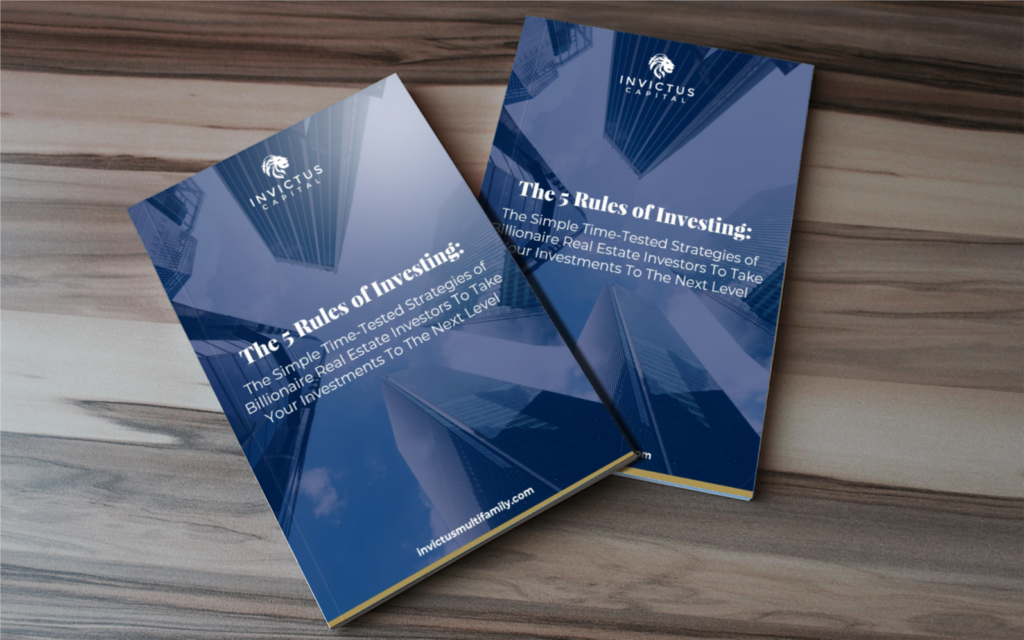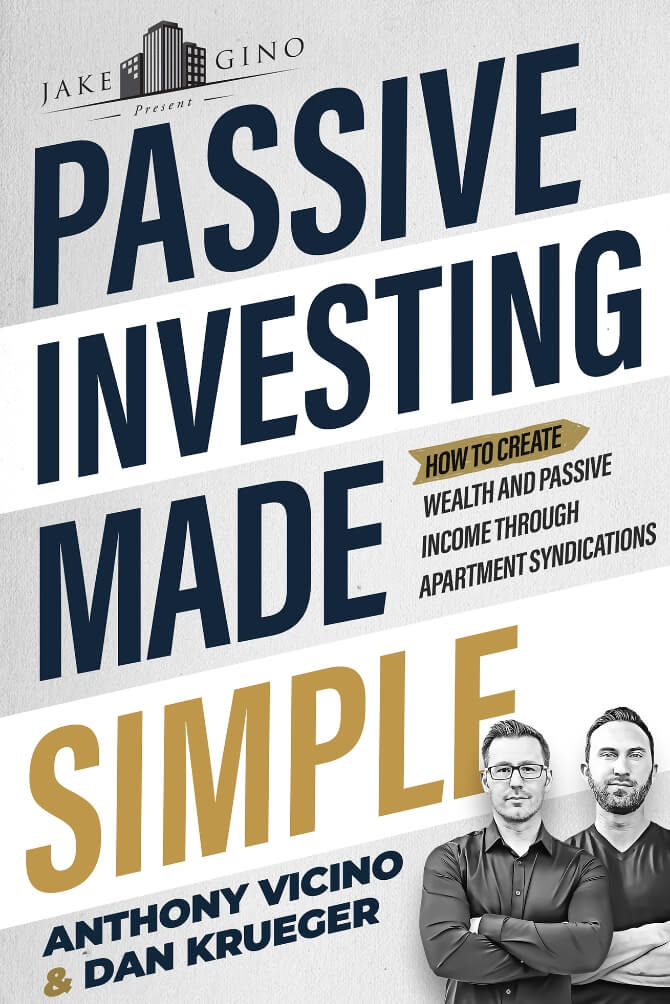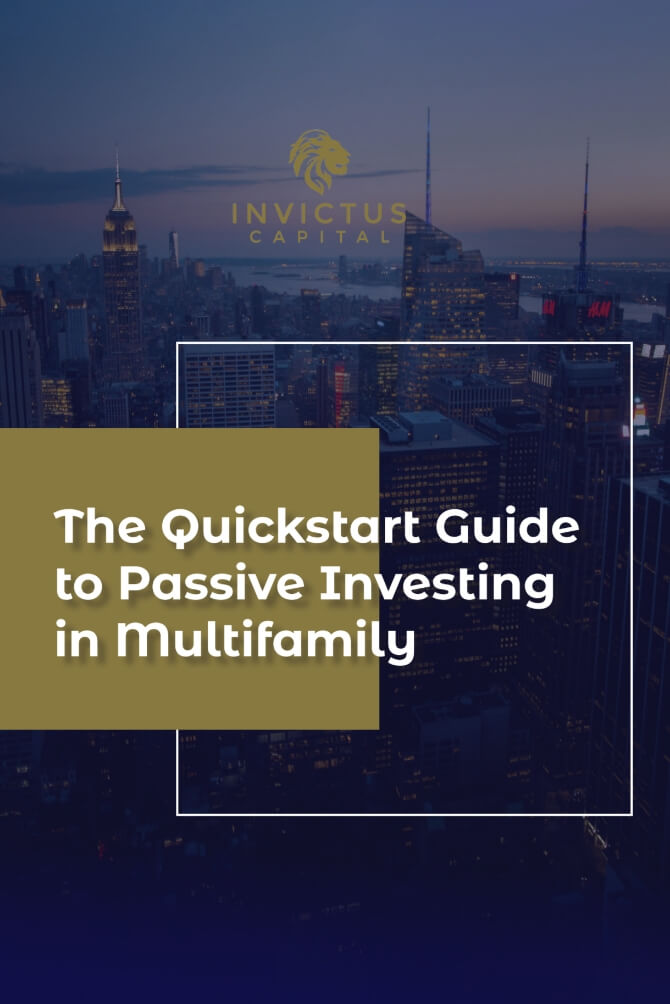For today’s episode, we will be discussing how to find money to actually invest in real estates.
We will go over what to do with how to overcome the $50k initial investment. Where and how do you invest?
What can we do from a position of cash to an overfunded life insurance policy.
We will talk about these things…and more in another episode of Multifamily Investing Made Simple in under 10 minutes.
Tweetable Quotes:
“if you and say your brother both have twenty-five thousand dollars and you want to invest in a deal, you could put them together in an LLC and then use that to invest into the deal.” – Anthony Vicino
“Sometimes combining resources like that could be very powerful.” – Dan Krueger
LEAVE A REVIEW if you liked this episode!!
Keep up with the podcast! Follow us on Apple, Stitcher, Google, and other podcast streaming platforms.
To learn more, visit us at https://invictusmultifamily.com/
**Want to learn more about investing with us?**
We’d love to learn more about you and your investment goals. Please fill out this form and let’s schedule a call: https://invictusmultifamily.com/contact/
**Let’s Connect On Social Media!**
LinkedIn: https://www.linkedin.com/company/11681388/admin/
Facebook: https://www.facebook.com/invictuscapitalventures/
YouTube: https://bit.ly/2Lc0ctX

Anthony Vicino: [00:00:14] Hello and welcome to multi-family investing, made simple in Under Ten Minutes, this is the podcast where we take the complexity out of real estate investing so that you can take action today and today.
Anthony Vicino: [00:00:24] We’re going to be doing that around the topic of how do you find the money to actually invest in real estate? I’m not sitting on, you know, just barrels of doubloons. Dan Kruger, what do I do if I’m not, I’m sitting on a chair from Staples. That was fifty dollars or more. But I want to invest in real estate because I know long term it’s a great investment vehicle. What do we do, man? Help me out.
Dan Kreuger: [00:00:48] Yes, that’s the biggest barrier to entry. Right, with the large multifamily properties is, you know, you’re going to have to put 25 percent down on something if you’re actively doing it yourself or if you’re investing as a passive investor nine times out of ten, there’s going to be a minimum of usually 50000 dollars to invest. So for a lot of people, that can seem a little bit daunting if they’re used to, you know, investing in mutual funds where you could invest as little as 20 some dollars into a share of something. So the big question is, how do you find 50 grand? There are a few key spots that you can look at. We’ll start with the biggest and most intuitive and most obvious, which is cash in your checking account or savings accounts. I get that out of the way just so we can have it on the list. And that’s a complete list, but that’s the obvious one. So what are some of the less intuitive sources for finding capital? I think one of the most readily available and one is the one the probably a lot of people don’t realize that they can tap into the same thing as their retirement funds.
Dan Kreuger: [00:01:54] So if you have a 401k that’s leftover from an old employer or if you’ve been, you know, contributing to your own IRA, maybe just in a Vanguard or Ameritrade account, you’ve got a Roth IRA or you’re shoving money outside of your you’re your 401k program through your employer, those funds can actually be utilized for investing into real estate. The key here is that you have to transfer those funds into something called a self-directed IRA. And I think one thing that’s confusing about that for a lot of people is that it sounds like a new kind of IRA account, kind of like you have your traditional IRA and you’ve got your Roth, then you’ve got the self-directed over here, which sounds like another version of an IRA account. But really self-directed IRA just means the custodian standing in the middle. So self-directed IRA is the same thing as Advantra I’m sorry, as Ameritrade or Vanguard. It’s just the institution standing in between you and your money. So the self-directed IRA is a special kind of institution that could facilitate the transaction if you choose to use retirement funds.
Anthony Vicino: [00:03:03] Now, the downside of using, say, a four one K or an IRA that you rolled into an IRA. The downside is that you can invest it into your own deal. You can’t invest it into a family member who’s related to you on the vertical family tree. So that’s your parents. If your dad has a deal, if your mom has a deal, you can’t invest in it, vice versa. Your parents can’t invest their retirement funds into your own deal. And but you can go horizontally, which is a little strange. So that means your siblings like you can have your siblings invest in your deal and you can invest in your siblings deal. So that lateral, as long as it lands, none of that vertical stuff. So that’s going to be a really powerful way. And honestly, most people that are investing into the types of syndications that we put together, They’re using self-directed funds from a retirement account because it’s you know, you can get better returns in that vehicle. And just a lot of people don’t realize it’s available. So another option that is available to people now, this is one that we haven’t talked about before, but I’ve been thinking about it recently. If you know there’s a fifty thousand dollar minimum now, that doesn’t necessarily mean it has to be all of your money. You could create an LLC, you could partner with somebody else, probably pull your money into the LLC entity, and then that LLC entity invests into the deal. Now you’re going to talk to the operator of the deal. They might not allow that. They might just be something they’re not familiar with or comfortable with. But functionally, if you and say your brother both have twenty-five thousand dollars and you want to invest in a deal, you could put them together in an LLC and then use that to invest into the deal.
Dan Kreuger: [00:04:39] Yeah, that’s a very creative strategy because as far as the operator of the deal is concerned, that’s one entity coming in. So checks the box of the 50000 dollars minimum. So it might be you and three coworkers or you and some buddies just that, just like to get together and talk about investing and stuff like that. Sometimes combining resources like that could be very powerful.
Anthony Vicino: [00:04:59] Mm hmm. Yep. So another way and now as we get into these other ways, I don’t know if I recommend them super highly for syndications in particular, but they’re great ways to get involved in real estate. If you’re looking to be an active investor, maybe get your first property under your own belt. The reason I don’t necessarily recommend them for syndication is that the syndication is a long-term hold. You’re going to have your money locked up for five to seven years in these next couple of sources. They’re a little bit better if you have an investment on a shorter horizon. So one of those is using your help. So if you have a home, a primary residence, you probably have a lot of equity tied up into it. For most people, that’s where the majority of their net worth resides. So you could borrow against that, open up a home equity line of credit, take that money and borrow against it and get that money working for you. As I said, though, I don’t know if that’s the best strategy in syndication because the Shylock rates are typically floating in relation to what used to be the LIBOR rate, like maybe one percent plus prime, maybe not so much these days, but it’s not so good to be in like an adjustable-rate vehicle like that when you’re locked in on a long term investment.
Dan Kreuger: [00:06:06] And the main thing is that you’re paying interest on the money. Unlike the self-directed IRA component and the pooling of resources with your friends, there’s no cost to capital to that per you’re not paying interest to get the money. So as we kind of go down this list of resources for finding the money, we’ve kind of ordered these in the way basically best or worst meaning as we go down, the cost of capital is going to increase. And I guess our opinion is that they become less and less ideal as we get to the bottom of the list here.
Anthony Vicino: [00:06:41] So it’s kind of like asking yourself what’s the highest and best use of my money and my equity, like getting that maximum velocity of capital. And let’s say you have one hundred thousand dollars of equity tied up into your primary residence. Right now, it’s just sitting there dead. It’s not doing anything for you. But if you could borrow that at, say, four percent interest rate and then invest that into some deal that’s generating a nine, 10, or above the delta between what you’re paying interest and what you’re receiving back and returns, it might justify, you know, doing that. But again, like your risk tolerance has to be there. You have to be comfortable with that. And again, I think it’s better if you’re doing a short-term fix and flip type thing where you’re going to get that money back a little bit quicker than in long-term syndication.
Dan Kreuger: [00:07:26] Yeah, and I probably recommend that if somebody has this amount of equity in their house and they’re fully capable of supporting a slightly higher mortgage, that instead of doing a hillock given where rates are right now, it’s probably better just to do a straight-up cash Al-Rifai, where you can lock in these historically low-interest rates. I think the average rate these days is, you know, well, the average is under three percent. But realistically, that’s not for most people. That’s people who have a really good credit score and people that are only talking about 50 percent leverage. But if you’re able to pull out about one hundred brand equity and still only pay about three and a half percent interest on that, and it’s fixed for thirty years. The rate of inflation is basically to wash out that that cost of capital there, so that’s a relatively lower risk way to do it as opposed to you lock you is more flexible. But the cash-out refires is a good way to get that capital and have that rate locked in for a long, a long period of time.
Anthony Vicino: [00:08:20] Yeah, that’s actually a really strong idea. I don’t know if we’ve talked about that one, but if you can justify it if you can withstand that higher mortgage payment, and honestly, depending on your terms with the low-interest rates, it might not be functionally all that much higher. Depends. So you might run that down with your lender and see where they find it. Now, the last option is one that you utilize to get into your very first deal.
Dan Kreuger: [00:08:44] Yeah. And honestly, if we’re going to put these in order, I’d put this above the Killock methodology. But another source of funds that people don’t really think of right away is using life insurance. This was something that I utilized to get into my first deal.
Dan Kreuger: [00:09:01] And if you’ve got a policy that’s structured appropriately, that has a lot of cash value to it, we’re not going to go down the full rabbit hole right now on this concept. But what you could do effectively is you could borrow against that life insurance policy and still leave the policy intact or not withdrawing the money. So the money in that account is still earning the dividend. You know, whatever the terms are that you’ve got on that policy, that it keeps functioning as it is, but it lets you utilize that capital in two places at once effectively. You know, the alternative to that is just liquidity, that if you don’t feel like you need a life insurance policy, you’re going to get things with taxes and fees and things like that. So I think it’s usually much better for people to borrow against it. Usually, the life insurance company that has holds the policy is the lender in that scenario. So you wouldn’t necessarily go to a bank and say, hey, can I borrow against this life insurance policy? They’ll certainly do that for you. But the easiest way to do it is just going to maybe Northwestern Mutual or something like that and say, hey, I’d like to take a policy loan against this. And you might have, you know, 60000 cash value in there. They’ll lend you sixty thousand dollars at basically the exact same rate of interest that they’re paying you in that account. So the interest you’re paying on the money that you’re borrowing is getting washed out by the interest it’s earning in the account. So it’s effectively not really costing you much. You still do need to, you know, pay the interest on it. But at the same time that you’re paying five, six, seven percent interest on the money you pulled out, you’re earning five, six, seven percent on the money that’s in the policy. So it’s a pretty powerful tool.
Anthony Vicino: [00:10:32] Yeah, that one superpower. I saved it for last because it might not be as applicable to the majority of the audience. You have to have a life insurance policy that has a decent amount of equity kind of established, which I think most people probably don’t.
Dan Kreuger: [00:10:45] So I’m going to add a caveat to that. There are a lot of people out there that really try to sell this concept hard and it’s not really efficient for people. If you just found out about this and you’re thinking about buying a life insurance policy for this purpose, no, not that efficient. It really only becomes efficient if you’re somebody who’s sitting on, you know, a large amount of money and you’re sitting there thinking, do I put this in savings account or oh, maybe there’s this life insurance play in that scenario that would be fairly effective. If it’s between a life insurance policy and a savings account, I’d say go with the life insurance policy. However, if you are if you’re thinking like, man, I only have a few thousand dollars, I’m going to start to throw this on the life insurance policy. It’s going to be a couple of years before you actually build up that cash value and you can actually start to utilize it. It’s not the most efficient, but if you already happen to have one or if you have a bunch of cash that you’re sitting there trying to figure out what to do with as opposed to turn it into a savings account that yields maybe a half a percent, the life insurance route might be the most efficient way for you to put that money where it’s earning something like five or six percent and you get to utilize it somewhere else at the same time. So yeah.
Anthony Vicino: [00:11:51] So those are a bunch of different ways that you can find money to get started investing in real estate. I have no idea if we went over ten minutes on this one, dear listener because I forgot to hit the stopwatch at the beginning of the episode. So that’s on me.
Anthony Vicino: [00:12:02] So if we went over ten minutes, don’t give us hate mail, but we will catch you guys next week and we promise next time we’ll keep it under the.


